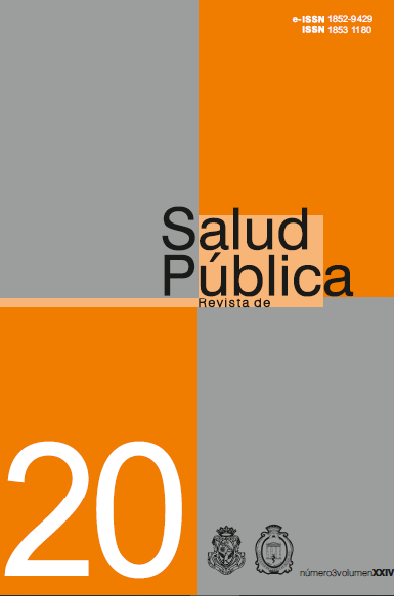Computer vision syndrome in patients with chonic diseases related with the visual display terminal (VDT) within and outside working hours
Keywords:
Ergonomics, Eye Health, Computer Terminals, Mobile Devices, Screen TimeAbstract
Objective: To explore the incidence of Computer Vision Syndrome (CVS) in patients with chronic diseases related to the use of Visual Display Terminals (VDT) on inside or outside working hours. Materials and Methods: Analytical descriptive study performed on 25 patients with chronic diseases in a medical center in Mendoza, Argentina. Socio-demographic variables were studied, and CVS was determined by means of the standardized CVS-Q questionnaire. Results: It was found that 68% of the sample were females, and age ranged between 20-80 years old (mean=50.12). Also 80% of the sample referred to use VDT within working hours obtaining an average of 2.64 ± 2.23 hours (mean ± ds). Conclusions: Of the 25 patients who participated in the study, 13 were above the CVS-Q threshold (≥6). It was found that 46% of respondents depend on devices with VDT in the work environment.
Downloads
References
Instituto Nacional de Seguridad e Higiene en el Trabajo. Guía técnica para la evaluación y prevención de los riesgos relativos a la utilización de equipos con pantallas de visualización. Madrid: Ministerio de Trabajo e Inmigración; 2000. Disponible en: http://www.insht.es/InshtWeb/Contenidos/Normativa/GuiasTecnicas/Ficheros/pantallas.pdf
American Optometric Association (AOA) [Internet]. St. Louis: The Association [cited 2013 Oct 30]. Available from: http://www.aoa.org/.
Francés T, Ronda A-Pérez, Seguí M. Alteraciones oculares y visuales en personas que trabajan con ordenador y son usuarias de lentes de contacto: una revisión bibliográfica. Rev. Esp. Salud Publica [Internet]. 2014 Abr [citado 2020 Feb 13]; 88 (2): 203-215. Disponibleen:http://scielo.isciii.es/scielo.php?script=sci_arttext&pid=S113557272014000200004&lng=es. http://dx.doi.org/10.4321/S1135-57272014000200004
Ranasinghe P, Wathurapatha WS, Perera YS, et al. Computer vision syndrome among computer office workers in a developing country: an evaluation of prevalence and risk factors. BMC Res Notes. 2016; 9:150. Published 2016 Mar 9. doi:10.1186/s13104-016-1962-1
Shima M, Nitta Y, Iwasaki A, Adachi M. Investigation of subjective symptoms among visual display terminal users and their affecting factors- analysis using log-linear models. Nippon Eiseigaku Zasshi. 1993; 47:10 32–40
Bhanderi DJ, Choudhary S, Doshi VG. A community-based study of asthenopia in computer operators. Indian J Ophthalmol. 2008 [08 julio 2019]; 56 (1):51–55. doi:10.4103/0301-4738.37596
Instituto Nacional de Estadística e Informática – INEI. Estadísticas de las Tecnologías de Información y Comunicación en los Hogares. INFORME TÉCNICO No 1 - Marzo 2014. https://www.inei.gob.pe/media/MenuRecursivo/boletines/tecnologias-de-informacion-y-comunicacion-en-los-hogares-oct-dic-2013.pdf
Rocha LE, Debert-Ribeiro M. Working conditions, visual fatigue, and mental health among systems analysts in São Paulo, Brazil. Occup Environ Med. 2004; 61 (1):24–32
Gálvez JF, Lou MJ, Andreu E. Ojo seco: diagnóstico y tratamiento. Información Terapéutica del Sistema Nacional de Salud. 1998; 22 (5): 117-120. Recuperado de: http://www.mscbs.gob.es/biblioPublic/publicaciones/docs/ojo.pdf
Rodríguez MF, Juyo A, Rojas A. Descripción de la metaplasia escamosa por citología de impresión en pacientes con ojo seco .Ciencia y Tecnología para la Salud Visual y Ocular.2007; 8:51-62.Recuperado de https://ciencia.lasalle.edu.co/svo/vol5/iss8/6/
Bennett GG, Glasgow RE. The delivery of public health interventions via the Internet: actualizing their potential. Annu Rev Public Health 2009; 30:273-292
Murray E, Burns J, See TS, Lai R, Nazareth I. Interactive Health Communication Applications for people with chronic disease. Cochrane Database Syst Rev 2005(4).
Fano Y. Síndrome de ojo seco en pacientes diabéticos de un área de salud. Rev Cubana Oftalmol [Internet]. 2017 Jun [citado 2020 Feb 14]; 30(2): 1-12. Disponible en: http://scielo.sld.cu/scielo.php?script=sci_arttext&pid=S0864-21762017000200004&lng=es.
Segui, M., Cabrero-García, J., Crespo, A., Verdú, J, and Ronda E. A reliable and valid questionnaire was developed to measure computer vision syndrome at the workplace. Journal of Clinical Epidemiology, 2015, 68(6); pp; 662-673.
Downloads
Published
How to Cite
Issue
Section
License
Copyright (c) 2020 Escuela de Salud Pública y Ambiente. Facultad de Ciencias Médicas. Universidad Nacional de Córdoba

This work is licensed under a Creative Commons Attribution-NonCommercial 4.0 International License.
Authors who publish with this journal agree to the following terms:
- Authors retain copyright and grant the journal right of first publication with the work simultaneously licensed under a Creative Commons Attribution License which allows the work to be copied, distributed, exhibited and interpreted as long as it is not done for commercial purposes.
- Authors are able to enter into separate, additional contractual arrangements for the non-exclusive distribution of the journal's published version of the work (e.g., post it to an institutional repository or publish it in a book), with an acknowledgement of its initial publication in this journal.
- Authors are permitted and encouraged to post their work online (e.g., in institutional repositories or on their website) after the publication process. (See The Effect of Open Access). (See The Effect of Open Access).



